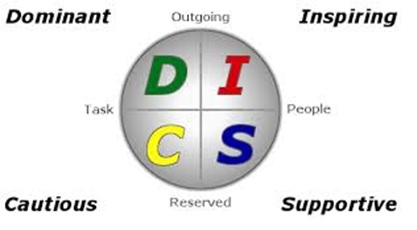Today, we wrap up the series of communication tips based on DISC styles with hints for strong C’s, the Mr. Spocks of the office.

Even if you don’t need it right now, you can bookmark the first article, which contains links to the others, and keep it for reference when you do run into a thorny communication problem with another style.
Was this helpful to you? Please comment or drop me a line if you liked it or want to see more on this topic. Feedback is always helpful!
If you’re a high C, here’s how you relate…
…to a high D:
People with the D style like to get right to the point. They want things to happen quickly and don’t want to spend a lot of time dwelling on specifics. You’re more likely to be careful and systematic, taking the time to point out logical objections. You may find their blunt, forceful approach to be pushy or reckless. They may see your persistent questions as a barrier to progress.
Strategies:
- Talk about big picture and bottom line rather than details
- Show them that you can move quickly when necessary
- Voice concerns, but avoid saying something “won’t work”.
- When solving problems, make them aware of potential issues but don’t let the conversation get bogged down in analysis.
- Consider their ideas even if they initially may seem too bold or daring.
- Offer your own ideas rather than rejecting their solutions.
- If things get tense, don’t hide your true feelings. That may drag on or escalate the situation.
- Communicate directly and objectively
- Address concern in a straightforward manner and avoid shutting down.
…to a high I:
People with the ‘I’ style tend to thrive in high-energy settings where they can work collaboratively. They’re probably more expressive and outgoing than you tend to be. Where you emphasize logic and careful decision making, they prioritize enthusiasm and thrive on spontaneity. They may see the C’s typical reserved, skeptical approach as cold or closed off.
- When trying to connect, recognize the value of their energy and spontaneity
- Focus on the positive and avoid appearing aloof.
- Join in collaborative efforts to show that you don’t discount the benefits of teamwork.
- When solving problems, be open to their more creative solutions, but help them see the potential consequences.
- Tap into their energy when the situation requires quick resolution.
- Refrain from overanalyzing or they may see you as perfectionist or inflexible.
- When things get tense, address conflict directly rather than withdrawing from emotionally-charged situations.
- Suggest logical ways to resolve the conflict, but avoid coming across as overly detached.
- Reassure them that a disagreement now doesn’t mean a poor relationship down the road.
…with the S style:
People with S style value cooperation and friendly interaction. You’re probably less interested in collaborating than they are, and they may have a difficult time understanding your more objective, reserved manner. They enjoy warm relationships and want everyone to feel included, so they may mistake a silent, detached approach for disapproval or dislike.
- When trying to connect, gain their trust by showing interest in their ideas and opinions.
- Remember that you may have to ask a few times before they’ll tell you what’s really bothering them.
- Avoid appearing too aloof, since they may take it personally.
- When problems need to be solved, establish a deadline for coming to solution and find ways to make minor decisions more quickly together.
- Consider risks and feasibility, but remember that more adventurous ideas sometimes lead to better results.
- Contribute your objective viewpoint, but don’t dwell on everything that could go wrong.
- When things get tense, address problems directly and objectively, but avoid being overly logical or withdrawn.
- Show openness to their opinions and feelings.
- Avoid dismissing the conflict unless you’re sure that it’s resolved.
…with another C:
People who share your C style would often rather focus on facts than feelings, and this might affect the way you relate to one another. They probably appreciate that you also tend to stay on task and leave personal matters out of the discussion. Because you both focus on logic and neither of you is likely to push for more openness, communication between you will probably be more restricted and polite.
- When trying to connect, focus on your shared need for objectivity, but try not to relate everything to tasks and logic.
- Allow time to get to know each other better to avoid misunderstandings.
- Respect your shared preference to work independently, but remain open to collaborative projects.
- When problems need to be solved, set a timeline for a solution to avoid getting bogged down in analysis.
- Focus on finding a mutually acceptable solution rather than getting into logic battles when you disagree on the correct approach.
- Avoid working so independently that you fail to communicate.
- When things get tense, focus on resolving the conflict respectfully and thoroughly rather than on proving you’re right.
- Refrain from getting caught up in arguments over whose position is more logical.
- Avoid pulling back from the argument before it’s clearly resolved since they’re also likely to withdraw.
Prompts/Pre-frames to use with a High C personality style or if you are a High C:
“My priority is quality and accuracy, sometimes, I feel you move to fast and that affects our quality and accuracy, that stresses me out, can we slow down to be sure we also maintain our high levels of quality?”
“I know sometimes, I am perceived as critical, please know that is not my intention, I am focused on perfection, please let me know if I have offended you.”
“Wow, what a great job you did setting up this service, would you be ok if I made a few adjustments?”
“I know you are not thrilled with change, if things feel like they are moving too fast, please let me know, so I can slow down and explain in more detail.”
“Your neatness and attention to detail are very important to making things run here, however, not everyone is wired just like you, and if they are not as detailed oriented, it does not mean they do not care.”
“We so appreciate your attention to detail, however, sometimes it seems like a project gets stuck because you feel like it is never good enough. What is the best way to help you move forward when we see this behavior?”
“As a manager, it is our job to get things done through others, sometimes I see you taking on the job of the people you manage because you feel like they cannot do it as well as you, how can I share this with you, so you can focus on your management duties?”


